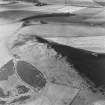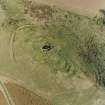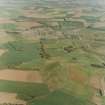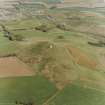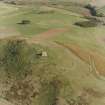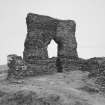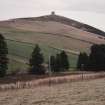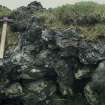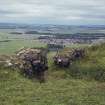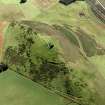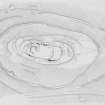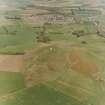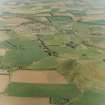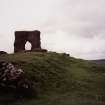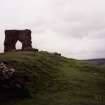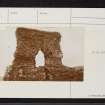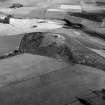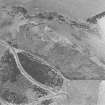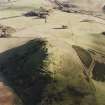Pricing Change
New pricing for orders of material from this site will come into place shortly. Charges for supply of digital images, digitisation on demand, prints and licensing will be altered.
Dunnideer
Castle (Medieval), Fort (Period Unassigned), Tower House (Medieval), Unidentified Pottery
Site Name Dunnideer
Classification Castle (Medieval), Fort (Period Unassigned), Tower House (Medieval), Unidentified Pottery
Alternative Name(s) Dunnydeer; Dunnideer Castle; Hill Of Dunnideer; Castle Of Dunnideer; Gregory's Wall
Canmore ID 18128
Site Number NJ62NW 1
NGR NJ 61215 28167
Datum OSGB36 - NGR
Permalink http://canmore.org.uk/site/18128
First 100 images shown. See the Collections panel (below) for a link to all digital images.
- Council Aberdeenshire
- Parish Insch
- Former Region Grampian
- Former District Gordon
- Former County Aberdeenshire
Castle of Dunnideer, c.1260. Weather-beaten rectangular tower, partly built from the remains of the prehistoric vitrified
fort in which it stands. Possibly the earliest tower-house on the Scottish mainland, its masonry is close-packed and striated; it is gathered to a rough course every 6ft or so in a manner seen at other early castles such as that other Balliol property, Red Castle, Angus, or at Boharm, Moray (qv). Single great shattered lancet of the first-floor great hall pierces the west gable.
Taken from "Aberdeenshire: Donside and Strathbogie - An Illustrated Architectural Guide", by Ian Shepherd, 2006. Published by the Rutland Press http://www.rias.org.uk
NJ62NW 1 61215 28167
For possible church within the fort, see NJ62NW 23.
For unenclosed platform settlement centred at NJ 612 280, see NJ62NW 35.
For bronze spearhead, socketed axe and sword from Dunnideer (NJ c. 61 28), see NJ62NW 25, NJ62NW 26, NJ62NW 29 respectively.
For adjacent rig (centred NJ 6099 2809), see NJ62NW 162.
(NJ 6124 2815) Castle of Dunnideer (NR)
Vitrified Fort (NR)
Gregory's Wall (NR)
OS 6" map, (1959)
The summit of Dunnideer Hill is occupied by a mediaeval tower, within a vitrified fort with outer works, which in turn is surrounded by an incomplete trivallate system of defence.
The highly vitrified fort (A on plan) is oblong and measures 220ft by 90ft internally, with a contemporary cistern near the W end (Feachem 1963). Slight traces of outer works (B) appear as a ruinous stony bank, best seen in the N and E, and absent on the steep SW flank.
The outermost line (E) of the trivallate defences, is represented only by the remains of a marker trench seen as a slight terrace, and situated well down the hill, enclosing an area c.950ft by c.600ft. Gaps for entrances have been left in the E and W. The inner line (D), slightly uphill is similar, but construction of a rampart has been started on either side of each entrance. The top line (c) is again similar, but cannot be followed across the steep SW hill slope (Feachem 1966).
The remains must represent at least two main structural phases, but no evidence exists to indicate whether the vitrified fort preceded the unfinished outworks or vice versa (Feachem 1963).
The Castle of Dunnideer was traditionally built by Gregory the Great in AD 890, but more likely by David, Earl of Huntingdon and Garioch in 1178: (Laing 1828). Simpson (1943) states that it is first mentioned in 1260 as the stronghold of Sir John de Balliol. It is built largely of material from the vitrified fort, (Feachem 1963) and probably represents the earliest authenticated example of a tower house in Scotland (Simpson 1943). The name Gregory's Wall applied to one of the walls of the castle (Ordnance Survey Name Book [ONB] 1867).
A Laing 1828; W D Simpson 1943; Name Book 1867; W D Simpson 1943; R W Feachem 1963; 1966.
Dunnideer Castle: remains of a mediaeval tower, vitrified fort (b) and unfinished fort, generally as described, illustrated and planned. There are also several hut platforms on the hill, for which see NJ62NW 35.
Feachem's (1966) plan indicates the remains of a wall bisecting the vitrified fort. This is actually the E wall of a building oriented N-S, whose turf-covered footings, c.0.2m high, measure c.13.0m by c.4.3m. Vague traces of another building oriented E-W are attached to its N end. They are presumably associated with the tower, which possibly had a courtyard on its E side, but they may be connected with St John's Chapel (See NJ62NW 22) which allegedly stood hereabouts.
Smith has found 14th-15th century pottery on the hill (information from Mr W Smith, Curator, Provost Skene's House, Aberdeen).
The name Gregory's Wall is no longer known locally.
Surveyed at 1/2500.
Visited by OS (RL) 12 March 1969; Information from MoW plaque.
Situated in an area of rough grazing on a prominent conical hill at an altitude of 265m OD, this vitrified fort and its outer works are in turn surrounded by an incomplete trivallate system of defences. Slight traces of outer works appear as a ruinous stony bank which is seen best on the N and E but absent on the steep SW flank.
The outermost line (E) of the trivallate defences is represented only by the remains of a marker trench seen as a slight terrace and situated well down the hill to enclose an area measuring about 950 ft (290m) by 600 ft (183m); gaps for entrances have been left in the E and W. Line (D) is similarly marked-out and lies between 50 ft (15.2m) and 150 ft (45.7m) inside line (E); in this case, work on the construction of a rampart has begun on either side of each entrance-gap. The third line (C) cannot be followed across the steep SW flank of the hill but is otherwise similar to the outer pair. The fourth line (B) is a ruinous stony bank which is feeble at best and absent on the steep SW flank of the hill, but otherwise similar to the outer pair (D and E); it probably represents an outwork.
The highly-vitrified innermost defence (A) encloses an area measuring 220 ft (67m) by 90 ft (27.4m) internally and is oblong on plan with a contemporary cistern near the W end; there is also a medieval tower within the interior.
These remains must represent at least two main structural phases, but no evidence exists to indicate whether the vitrified fort preceded the unfinished outworks or vice versa.
Visited by GRC/AAS, November 1977, May 1985, August 1990 and September 1988; air and ground photographs listed.
NMRS, MS/712/19 and MS/712/36.
Air photographs: AAS/77/3/SC/15 and AAS/94/02/G4/9-13.
(Additional bibliography and newspaper references cited).
NMRS, MS/712/21 and MS/712/58.
Air photographs: AAS/00/02/G2/14-15 and AAS/00/02/CT.
NMRS, MS/712/100.
Scheduled as Hill of Dunnideer, fort, platform settlement and tower... the remains of a prehistoric fort with fine visible lines of defence, and possible related settlement and a medieval tower, situated in an area of rough grazing on a prominent conical hill at an altitide of 265m OD..
Information from Historic Scotland, scheduling document dated 2 December 2003.
(Classification amended to: Fort; Castle; Tower-house; Pottery). The Castle of Dunnideer, which stands within the remains of the vitrified fort on the summit of the hill of Dunnideer, is now in a sadly ruinous state and from a distance resembles nothing more than a folly. It comprises a tower and the traces of a robbed-out structure to the east, all of which are confined within the inner rampart of the vitrified fort. Consolidation, presumably in the 19th century, has rendered interpretation of the remains difficult, and the only facts that can be stated with certainty are the shape of the tower, which is rectangular, measuring 15m by 12.5m over coursed-rubble walls 1.9m thick. A splayed plinth on the W wall and a blocked opening central to the same wall at ground level may or may not be original. A ground-floor opening at the N end of the E wall is slightly more convincing as an original feature. The only feature to survive at first-floor level is the apex of an arch of a pointed window, which must have lit a first-floor hall. The building does not appear to have been vaulted.
In 1260 Josceline de Baliol, Lord of Dunnideer, granted to the abbey of Lindores permission to construct a lade from the River Urie to the mill of Insch 'by the middle of the land which he has on the east of his castle of Donidor' (Lindores Chartulary 1903). That his castle is the ruin on Dunnideer seems the inescapable conclusion. The apparent lack of vaulting, the arch-pointed first-floor window and the builder's skilful use of rubble, all point to an early date. It certainly bears little resemblance to any late medieval tower-houses
Visited by RCAHMS (PJD) 8 June 2000
Lindores Chartulary 1903.
NJ 612 281 An assessment was conducted in December 2005 to record in three dimensions the extent of the damage to archaeological resources caused by a fire that burnt over a considerable proportion of the southern slopes of Dunnideer Hill in early October 2005. The assessment established the extent, varying character and severity of damage caused by the fire to archaeological remains. Archaeological survey within the burnt area led to the discovery of several previously unrecognised features, including lengths of bank/rampart and small artificial scoops or platforms. Test-pitting indicated that burning had not penetrated through the topsoil in the areas examined, but provided some limited information on the character of certain archaeological features. In one test-pit a short length of the outside face of the wall of the vitrified fort was exposed.
A small assemblage of artefacts was recovered from fieldwalking, metal-detecting and test-pitting within the burnt area, including one possible sherd of prehistoric pottery, sherds of medieval and post-medieval pottery, and flint flakes. Medieval pottery had also been recovered from the burnt area by representatives of Aberdeenshire Council Archaeology Service. Full results and management recommendations are in a report lodged with the NMRS and Aberdeenshire Council SMR.
Archive to be deposited in NMRS. Report lodged with Aberdeenshire SMR and NMRS.
Sponsor: Historic Scotland
S Badger and A Dunwell, 2006.
Field Visit (21 May 1957)
Forts, Hill of Dunnideer.
The Hill of Dunnideer, one mile west of Insch, rises only 400 ft from the valley of the Shevock to attain a height of 876 ft OD, but its situation relative to the country in the vicinity is such that it commands an extensive view in all directions, especially to the east. To the observer on Barra Hill [NJ82NW 4], 12 miles to the east and halfway to the coast, the Hill of Dunnideer, despite its comparatively small size, takes its place among the conspicuous group that includes Tap o’Noth [NJ42NE 1] and the Mither Tap of Bennachie [NJ62SE 1]. The remains of five separate lines of defence can be observed on the hill (see plan); it will be convenient to describe each separately before an attempt is made to determine the nature of the structures or structures of which they form part. The innermost, crowning the oval summit of the hill, is a highly vitrified wall (A on the published plan) which encloses a subrectangular area measuring 200 ft in length from east to west by 90 ft in breadth. The construction of a stone tower and its appendages within the fort in medieval times has a further degree of mutilation to the ravages of time, so that no detail of the wall can be observed. It is possible that the depression about 10ft in diameter that lies immediately east of the tower might have been the well of the fort. There are no surface indications that suggest where the entrance through the vitrified wall originally lay. The next line of defence (B) lies at distances which vary from 80ft to 20ft from the vitrified wall. Surrounding an area 350ft in length and 150ft in breadth, it consist of a ruinous stone wall most of which is now represented by a stony scarp 12 or 15ft in width and about 4ft in height. The south section, which lies along the steeper flank of the hill, is represented by a mere crest-line. The SW arc is breached by a gap some 20ft wide, the south side of which is bordered and covered by a short continuation to the west from the south section of the rampart. It is possible that this entrance was used, if indeed not made, in the medieval period. In the space between the east arcs of this rampart and the vitrified wall is a stony mound 60ft in length, up to 12ft in breadth and 2ft in height, immediately east of which are two broad quarry ditches. Nothing exists to show what relation, if any, this complex bears to the other remains.
The third line of defence (C) is a fragmentary rampart which runs around the east and north faces of the hill at distances between 50ft and 10ft from rampart B. The east arc, 230ft in length, appears as a slight scarp, while a similar length of the adjacent north section takes the form of a narrow terrace, possible originally a marker trench (see below). The NW arc, 150ft in length, shows as a mere crest, and no remains at all can be distinguished along the SW or S faces of the hill. It complete this rampart would have enclosed an area measuring 470ft in length by about 230ft in breadth.
The fourth rampart (D) lies lower down the hill at distances varying from 130ft to 40ft from C. It encloses an area measuring 700ft in length and 430ft in breadth but was clearly never completed. The remains show that the line of the rampart was first marked out by a shallow trench with the spoil on the outer lip; long stretches of work at this stage can be seen as terraces on the north and south sides of the hill. Work was then begun on building up the rampart, starting on either side of the entrances represented by gaps in the east and west arcs (cf Durnhill [NJ56SE 4]). This phase entailed digging a quarry ditch some 20ft outside the marker trench and throwing the material this provided up on to the natural hill slope between the two trenches. At the same time the material quarried from the back of the marker trench was thrown forward and thus a rubble rampart began to take shape. The remains of the uncompleted rampart south of the west entrance now stands at best to a height of 12ft above the bottom of the quarry ditch and to 1ft above the bottom of the marker trench.
The fifth rampart (E) lies at distances varying from 150ft to 50ft from D, according to the disposition of the contour of the hillside, and encloses an area measuring 1,000ft in length and 600ft in breadth. This rampart is represented entirely by a marker trench, no trace of work of the second stage being visible. The west entrance conforms to that of D, but the E one, together with stretches of the marker trench on either side of it, has been obliterated on the surface by rig and furrow ploughing.
It will be seen that the outer three ramparts all include stretches of marker trenches, and that as far as can be detected work of the next structural phase was started on the median one, D. The fact that the work was begun in this way shows that the builders of this one, and probably those of the other two, were starting to erect heavy rubble ramparts possibly faced or supported with wood or stone revetments and with external ditches. The other two defences, however, consist of the vitrified wall and the very ruinous but recognisable stone wall immediately outside it. Nowhere to the various lines of defence overlap nor are there any obvious points at which their relationship to each other is manifest. However, in view of the similarities in their present appearance, the likelihood exists that the outer three may represent an uncompleted fort of three ramparts and that the inner two were later than and independent of this. It is possible that the inner two represent two successive phases, the former consisting solely of the stone wall and the latter of the vitrified wall; but it is also possible that these two represent one phase in which the inner, vitrified, wall was covered by an outer one which may or may not have had timber reinforcements.
Visited by RCAHMS (RWF) 21 May 1957.
Publication Account (1986)
At least two phases of prehistoric defences crown this prominent hill which rises to 268m OD on the west of the Garioch. The medieval tower was built c 1260, partly from prehistoric stonework and is one of the earliest stone castles in Scotland. Three outer, sketchy, lines of defence have been interpreted as an unfinished fort, probably secondary to the hilltop enclosure. The central line CD on plan), on the hill flanks c 60m down from the summit, is the clearest, being represented by a rampart and ditch at the WSW and ESE, linked by slight marker trenches. The inner and outer lines CC and E) are only evident as breaks of slope in certain areas.
The summit defences consist of two stone walls, the outer CB) being a low stony bank, clearest on the east and absent on the south. The inner CA) represents the vitrified fort, an oblong enclosure 65m by 25m, with no clear entrance. The intensity of the burning that caused the vitrification can be seen in the fused masses of stone lying to north and south; impressions of the burnt-out timbers can be seen in places. A depression under the south-eastern corner of the castle is probably the cistern for the fort.
Seven hut platforms are scooped into the slopes c 45m downslope to north and south of the summit, five on the south and two on the north. The largest is 12m by 7.5m. They probably pre-date the unfmished fort as its marker line CD) respects the outer rim of one of the southern platforms.
Opposite Dunnideer, on Hill of Christ's Kirk CNJ 601274), are the remains of another unfmished fort represented by three marker trenches enclosing a palisade slot 40m in diameter.
Information from ‘Exploring Scotland’s Heritage: Grampian’, (1986).
Field Visit (29 October 1996)
The defences of the fort on the Hill of Dunnideer surround the stump of a medieval tower that dominates the landscape of the Garioch for miles around. The defences comprise two main elements: the first represented by as many as four walls or ramparts enclosing the summit of the hill and centred on a vitrified wall; the second by two outer ramparts enclosing much larger areas and encircling the lower flanks of the hill.
The vitrified wall encloses an oval-shaped area that measures about 68m from WNW to ESE by 23m transversely and has been extensively robbed to build the tower which may have had an adjoining enclosure to the ESE and is now represented by a low band of rubble cutting across the interior. The vitrified wall lies within the grass-grown remains of an earlier oval enclosure defined by a wall reduced to a scarp and measuring about 100m in length by 45m in breadth. Beyond this, and most visible at the WNW end, are the scarps of another two lines of defence, the inner of which contours around the N side of the hill where it is overlain by a row of three house platforms on the E.
The outer defences are both low grass grown ramparts created by material quarried internally, the inner enclosing an area measuring about 210m from WNW to ESE by 120m transversely and the outer measuring about 300m by 175m. The inner is the better preserved and has entrances on the ESE and WNW, the latter where the rampart expands in size and the ditches terminate to form a causeway. The outer enclosure also has an entrance on the WNW but is defined as little more than a terrace for much of its circuit and has been ploughed out by rig and furrow cultivation on the ESE.
There are traces of at least a further seven house platforms within and below the defences, two of which on the W have been set into the lowermost rampart.
Visited by RCAHMS (ARG, IP) 29 October 1996.
Publication Account (1996)
At least two phases of prehistoric defences crown this prominent hill which rises to 268m OD on the west of the Garioch. The medieval tower was built c 1260, partly from prehistoric stonework and is one of the earliest stone castles in Scotland. Three outer, sketchy, lines of defence have been interpreted as an unfinished fort, probably secondary to the hilltop enclosure. The central line (D on plan), on the hill flanks c 60m down from the summit, is the clearest, being represented by a rampart and ditch at the WSW and ESE, linked by slight marker trenches. The inner and outer lines (e and E) are only evident as breaks of slope in certain areas.
The summit defences consist of two stone walls, the outer (B) being a low stony bank, clearest on the east and absent on the south. The inner (A) represents the vitrified fort, an oblong enclosure 65m by 25m, with no clear entrance. The intensity of the burning that caused the vitrification can be seen in the fused masses of stone lying to north and south; impressions of the burnt-out timbers can be seen in places. A depression under the south-eastern corner of the castle is probably the cistern for the fort.
Seven hut platforms are scooped into the slopes c 45m downslope to north and south of the summit, five on the south and two on the north. The largest is 12m by 7.5m. They probably pre-date the unfinished fort as its marker line (D) respects the outer rim of one of the southern platforms. Opposite Dunnideer, on Hill of Christ's Kirk (N] 601274), are the remains of another unfinished fort represented by three marker trenches enclosing a palisade slot 40m in diameter.
Information from ‘Exploring Scotland’s Heritage: Aberdeen and North-East Scotland’, (1996).
Archaeological Evaluation (21 July 2008 - 1 August 2008)
NJ 6942 2435 and NJ 61215 28167 The RCAHMS volume on Strathdon identified six types of hillforts based on size and defensive systems. However, none of the sites have been dated. The Hillforts of Strathdon Project aims to recover dating evidence from one of each of the six classes of hillfort.
The second season, 21 July–1 August 2008, returned to Maiden Castle and opened a single trench on Dunnideer. The work identified a secondary rectilinear structure in the interior which was overlain by a soil layer onto which a post-built structure, associated with paving was constructed. Finds included crucibles, an unfinished stone bead, a glass bead and decorated glass sherd.
The work identified the inner face, recovered charcoal from the destruction of the site and confirmed that the rampart was at least 4m wide.
Archive: RCAHMS (intended)
Funder: AOC Archaeology, Aberdeenshire Council, The Mackichan Trust, The Hunter Archaeological Trust, Glasgow Archaeological Society and the CBA.
Murray Cook, Lindsay Dunbar and Rob Engl (AOC Archaeology Group), 2008
Note (17 April 2015 - 31 August 2016)
The keep of the castle that occupies the interior of the fort on the summit of Hill of Dunnideer is a well-known landmark visible throughout the Garioch. The defences of the fort comprise two main elements: an inner core representing up to four walls or ramparts and several phases of construction centred on a vitrified wall enclosing the very summit of the hill; and two outer ramparts forming a much bigger enclosure extending down the flanks of the hill. The vitrified wall has been heavily robbed, partly to build the keep overlying the WNW end, which was probably also accompanied by some form of enclosure extending ESE, though this has also been heavily robbed and is represented by little more than a robber trench and a band of rubble cutting across the interior of the fort some 30m to the ESE. The extent of this fort is marked out by large exposed masses of vitrifaction, suggesting an enclosure measuring about 65m from ESE to WNW by 23m transversely (0.16ha). This lies within a rather larger oval enclosure measuring about 100m in length by 42m in breadth (0.32ha) within a rampart reduced to a scarp, which is possibly an earlier line of defence with an entrance where the access track climbs the slope from the W. At least two heavily degraded ramparts reduced to scarps lie outside this line at this end, the inner of which can also be traced along the N flank of the hill to peter out on the E, where it is overlain by a row of three circular house platforms; these could be outworks to the larger enclosure on the summit, or indeed the remains of yet earlier defences. The outer enclosures display a markedly different character to the core of inner defences. Both comprise low ramparts constructed from material grubbed up from an internal quarry, though in places only the terrace of the rampart is visible. The inner is pierced by entrances on both the ESE and WNW, the latter approached from a gap in the outer across a causeway across the external ditch that accompanies the rampart round this end. Richard Feachem considered both this circuit and the even slighter line below it the remains of marker trenches for unfinished works (Feachem 1963, 105), but they are consistent features that gradually expand in size towards the entrances at either end, suggesting that both are as their builders intended, and possibly largely constructed in timber. The inner encloses an area measuring about 210m from ESE to WNW by 120m transversely (2.25ha), while the outer, which has been ploughed down by the cultivation of rigs at the ESE end is even larger, probably originally enclosing 3.6ha. In addition to the three already noted, there are traces of up to seven house platforms within the inner of the outer enclosures, but there are also a scatter of much better formed larger platforms outside both ends, two of those on the W apparently cut back into the line of the outermost perimeter. An evaluation trench dug in 2008 recovered charcoal samples from within and beneath rubble thought to have collapsed from the vitrified wall; they have returned dates of 360-160 BC, while archaeomagnetic dates from the vitrifaction span the period 606- 275 BC (Cook 2010, 85-6).
Information from An Atlas of Hillforts of Great Britain and Ireland – 31 August 2016. Atlas of Hillforts SC2959













































































![Engraving of Dunnideer Castle.
Titled: 'Dunadeer. This castle also called Dun O' Dore stands on the summit of a considerable hill, rising out of the flat country of the Garrioch, about 12 miles from Old Meldrum. It was a place of great strength, defended by a double ditch and rampart. The building is now entirely demolished , except part of one end, which is the subject of the above plate. It is said to have been the residence of Gregory the Great, King of Scotland, who, in the year 892, according to Leslie and other Scottish historians, died in this Castle, and was from hence carried to Iona, where he was buried. ADC.' [Adam de Cardonnell.]](http://i.rcahms.gov.uk/canmore/l/DP00094368.jpg)




























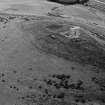
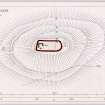
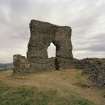


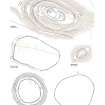
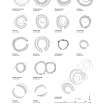

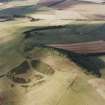
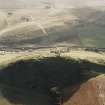
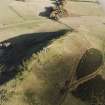
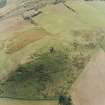
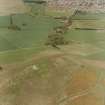
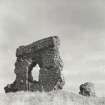
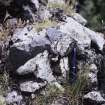
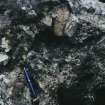
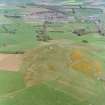
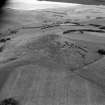
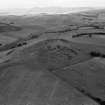
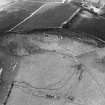
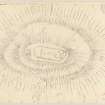

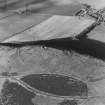
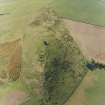
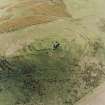
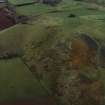
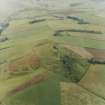
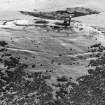



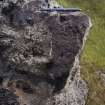
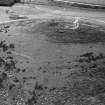
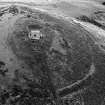


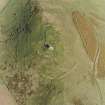
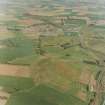
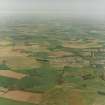
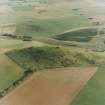
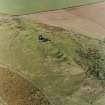
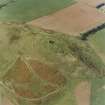
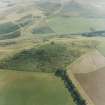

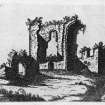
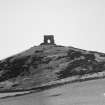
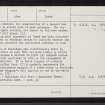
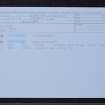
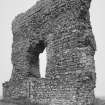
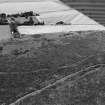
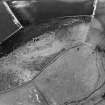
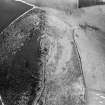

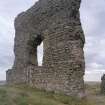

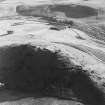
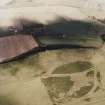
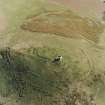
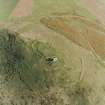

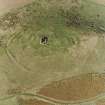
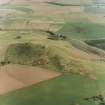
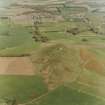
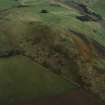
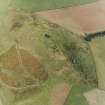
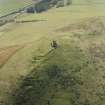
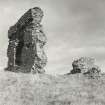
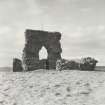
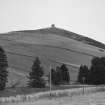
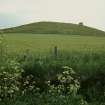
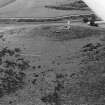
![Engraving of Dunnideer Castle.
Titled: 'Dunadeer. This castle also called Dun O' Dore stands on the summit of a considerable hill, rising out of the flat country of the Garrioch, about 12 miles from Old Meldrum. It was a place of great strength, defended by a double ditch and rampart. The building is now entirely demolished , except part of one end, which is the subject of the above plate. It is said to have been the residence of Gregory the Great, King of Scotland, who, in the year 892, according to Leslie and other Scottish historians, died in this Castle, and was from hence carried to Iona, where he was buried. ADC.' [Adam de Cardonnell.]](http://i.rcahms.gov.uk/canmore/s/DP00094368.jpg)


